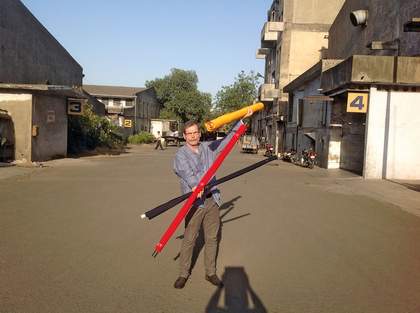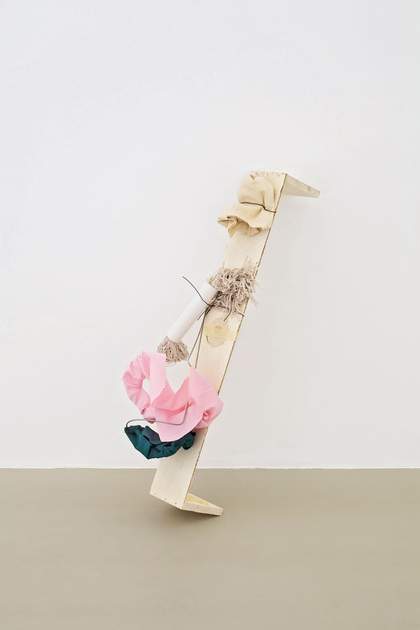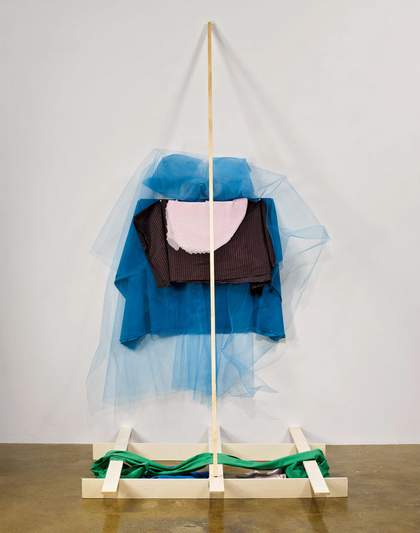
Richard Tuttle in Surat, India, 2013, photographed by Achim Borchardt-Hume
© Achim Borchardt-Hume, courtesy the artist and Achim Borchardt-Hume
The work of Richard Tuttle resists general concepts. This is its advantage, its value. His objects, installations and books demand no collective understanding of what they might mean, or what he might mean. His art induces others to concentrate on their own responsive feelings.
The forms and structures that Tuttle develops are seductively casual, yet precise – and often so fragile in appearance that we suspect they might be altered by the mere force of our attention. His primary materials can be fragments of paper pulp barely adhering to a thin fabric mesh. Yet we cannot imagine the configuration being other than what it is. In front of a Tuttle object, we re-learn to see; perusing a Tuttle book, we re-learn to read. We need not recognise or realise any particular notion as the ultimate significance of this art, other than what each of its instances means here and now – to each of us. The prerequisite to understanding Tuttle is nothing more, nothing less, than to be living a life.

Richard Tuttle
Hello, The Roses 6 2012
wood, wire, fabric, strng, plastic, tape, 916mm x 300mm x 360mm
© Richard Tuttle, courtesy Stuart Shave/Modern Art, London
An obvious generalisation can nevertheless be ventured: there is an art to every art. Some profoundly cultivated skill must facilitate what Tuttle does, marking each of his creative actions. On occasion, he has identified his skill with what he calls ‘care’. He can draw a line, bend a wire and drape a fabric – performing these actions in a very special way, just so – because he cares about the transient sensations and ordinary encounters of life more than others normally do. His caring generates an art, tantamount to a mode of living. This is what he cultivates: living. A caring act of artistic invention accomplishes its work without doing a noticeably good job any more than it does a noticeably bad job; it avoids making a fetish of its own caring. And here a paradox is evident, for Tuttle claims that the aim of his art is to produce something other than what we call ‘art’ and its aesthetic perfections. Analogously, the work is not ‘his’ because it takes him beyond everything he knows. ‘If I can free a humble material from itself,’ he has said, ‘perhaps I can free myself from myself.’ To what end? ‘I think that I get a chance to be aware.’ Tuttle is offering us this chance; his chance becomes our chance. We can be thoroughly aware.

Richard Tuttle
Looking for the Map 8 2013-4
fabric, wood, armature wire, foam core, paint, push pins, straight pins, 2362mm x 1219mm x 1219mm
© Richard Tuttle, courtesy the artist and Pace Gallery, New York
At its core, Tuttle’s art is communicative. It speaks to its maker as he makes it, and it suits all of us as the social animals we are. Human well-being, if not survival, depends on communication with others by whatever means: gesture, word, inscription, signs of all kinds. We constantly send out messages and interpret signs in turn. Our minds, bodies and senses – as well as our emotions – are engaged in the exchange of messages and meanings, as are the objects, materials and spaces with which we interact. This ubiquitous communication demands care.
The ‘humble material’ of Tuttle’s message can be a mere fragment of neutral fabric or – with his project for the Tate Modern Turbine Hall – great expanses of several textiles, richly dyed. He seems fascinated by the pliant, organic nature of fibrous materials of all kinds, which include not only textiles, but paper, processed wood, rope and string, and even certain types of tape, that can be cut, torn, bent, unravelled, frayed, tacked, tied, or knotted. Textiles in particular are so flexible – they have such tensile strength – that they appear to form fixed objects and fluid spaces simultaneously. Tuttle works with textiles applying the same respect with which he would direct or touch a living body. This is logical, since we use woven fabrics to clothe ourselves, ensuring that body and material combine in a communicative gesture. Whatever message our body conveys is most often ‘clothed’ or ‘coloured’ by a textile. I recall how Tuttle once interrupted our conversation abruptly, struck by the play of light on the crease of a blouse; the effect, its meaning for him, superseded the concepts we had been debating. I quickly understood that his distraction was to my benefit.

Richard Tuttle
Walking on Air, C10 2009
Cotton with Rit dyes, grommets, thread
2x panels, overall installed:
1ft 11 inches x 10ft 3 inches/58.4 x 312.4 cm
Photograph by Kerry Ryan McFate, courtesy Pace Gallery
Image © Richard Tuttle, courtesy Stuart Shave/Modern Art, London and Pace Gallery, New York
All fabrics play a game with their colour and the light that articulates their pliant surfaces. We have only to pay attention. When we think about what we see and feel, metaphors and puns come naturally to these sensory experiences, which are so basic to daily life. Colours ‘colour’ our mood (a metaphor). Light ‘lightens’ our concerns (a pun involving both vision and touch). With his words, Tuttle is deeply poetic, just as he is deeply figurative with materials (‘figurative’ in a rhetorical sense: developing multiple configurations of meaning). He titles his project for the Turbine Hall, I Don’t Know . The Weave of Textile Language. What can this mean? We should not expect a definitive answer to the verbal challenge, any more than we expect our response to the physicality of Tuttle’s colours and spaces to cohere as a fixed judgment. A linguistic text is a weave of language, like a textile not only with respect to its interlocking structure but also in the sense that its communicative force extends in all directions by multiple pathways of messaging.
This film file is broken and is being removed. Sorry for any inconvenience this causes.
TateShots: Richard Tuttle - I Don't Know
The puns associated with text and textile are rich. But what about Tuttle’s ‘I don’t know’? His title is consistent with the thought that we never know – or should not believe that we know – where language or a gesture (of a line, of a fabric) may be leading. Tuttle himself does not know, but he trusts his capacity to make the best judgment because he cares for the entirety of his experience. He is willing to risk his judgment on a grand scale. ‘Perhaps I can free myself from myself,’ he says, as if proclaiming: ‘Perhaps I can open myself to not knowing, not prejudging my own sensations, learning from experience at its fullest.’ He will not understand what he has done for the Turbine Hall until he has done it and seen it and felt it. Even then, he might not ‘know’ – he is still learning. We do well to take our cue from him, from his living art.

